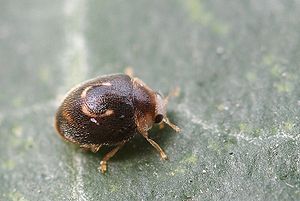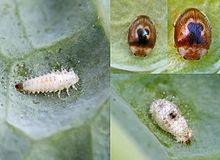Bow dwarf ladybug
| Bow dwarf ladybug | ||||||||||||
|---|---|---|---|---|---|---|---|---|---|---|---|---|

Bow dwarf ladybug ( Clitostethus arcuatus ) |
||||||||||||
| Systematics | ||||||||||||
|
||||||||||||
| Scientific name | ||||||||||||
| Clitostethus arcuatus | ||||||||||||
| ( Rossi , 1794) |
The bow dwarf ladybird ( Clitostethus arcuatus ) is a ladybird from the Scymnini tribe , to which mainly very small species belong.
features
The beetles are 1.2 to 1.5 millimeters long and have a shiny and hairy body. The drawing on the wings usually forms an arch in the shape of a horseshoe, this is colored beige, the body itself is black. However, the drawing is variable and can also show dark spots with a light border. In the drawing it resembles the single-colored ladybug , but it is much smaller than this one. The bow-dwarf ladybird differs from Scymnus species in that it has longer antennae and a shortened prosternum in front of the anterior coxae .
Occurrence
The bugs are thermophilic and in Europe mainly Mediterranean spread. In Central Europe, they come in heat-favored places z. B. in the Upper Rhine Graben. They live in ivy , hardwood and softwood . The beetles are classified in the Red List as “critically endangered” (Category 2).
Lifestyle and diet
The bow dwarf ladybirds are rare and usually appear as solitary animals or in pairs, but if the conditions are favorable, they can also occur in larger groups. They feed mainly on whale insects from the Aleyrodidae family native to Europe . In California they are therefore used for biological control of the introduced Siphoninus phillyreae , which attacks ash trees , but also numerous fruit trees and citrus plants. The larvae of the bow ladybug use not only their legs, but also the pygopodium and mouthparts to move easily on smooth leaves, such as those of citrus fruits.
During feeding tests at the Institute for Biological Pest Control of the Federal Biological Research Center for Agriculture and Forestry in Darmstadt , it was found that a larva of the bow ladybird can eat an average of 544 (± 189) eggs of the great white scallop ( Aleyrodes proletella ) before pupation . In this experiment, the adult males of the beetles ate an average of 27 eggs, the females 61 eggs per day. The adults reach an average age of 150 days in the laboratory. In nature, the beetles not only eat the eggs, but also larvae, pupae and adult specimens of whiteflies.
The bow-dwarf ladybirds lay their eggs between the nymphs of the moth lice on the underside of the leaf. The development from egg to larva to adult beetle takes a total of 25 days under laboratory conditions at a temperature of 20 ° C. The beetles can form three overlapping generations in southern central Europe between May and early November. In warmer climates, the first adult beetles can appear as early as February and up to twelve generations can appear each year. The eggs of the last generation of the year overwinter after the female has laid them. The larvae do not hatch until the next spring.
Individual evidence
- ↑ Federal Agency for Nature Conservation (Ed.): Red List of Endangered Animals in Germany . Landwirtschaftsverlag, Münster 1998, ISBN 3-89624-110-9 .
- ↑ Record of Clitostethus arcuatus in the Dornhecke forest near Bad Schönborn (North Baden) at kerbtier.de (last paragraph) published on February 14, 2009
- ↑ a b Tom S. Bellows, Timothy D. Paine, Ken Y. Arakawa, Carol Meisenbacher, Paula Leddy, John N. Kabashima: Biological control sought for ash whitefly. In: California Agriculture. 44, No. 1, 1990, pp. 4-6 ( full version , English)
- ^ C. Ricci, G. Cappelletti: Relationship between some morphological structures and locomotion of Clitostethus arcuatus Rossi (Coleoptera Coccinellidae), a whitefly predator. In: Frustula Entomologica. 11, 1988, pp. 195-202
- ↑ H. Bathon and Jutta Pietrzik: On the feeding of the bow ladybird, Clitostethus arcuatus (Rossi) (Col., Coccinellidae), a killer of the cabbage louse, Aleurodes proletella Linné (Hom., Aleurodidae). In: Journal of Applied Entomology. 102, 1-5, 2009, pp. 321-326
- ↑ TS Bellows, TW Fisher: Handbook of biological control: principles and applications of biological control. Academic Press Inc., 1999, ISBN 0-12257-305-6 , pp. 441-442
- ↑ José Adriano Mota, António Onofre Soares and Patrícia Ventura Garcia: Temperature dependence for development of the whitefly predator Clitostethus arcuatus (Rossi). In: BioControl. 53, 4, 2008, pp. 603-613
Web links
- Clitostethus arcuatus at Fauna Europaea
- Clitostethus arcuatus description (Dutch)
- Website of the Watford Coleoptera Group Occurrence in England with description

